Managing Knowledge and Information
VerifiedAdded on 2023/01/07
|9
|2622
|76
AI Summary
This document discusses the significance of knowledge management in helping companies achieve long-term objectives, the influence of RFID on business process efficiency, key security threats to information systems, and strategies to reduce risk.
Contribute Materials
Your contribution can guide someone’s learning journey. Share your
documents today.
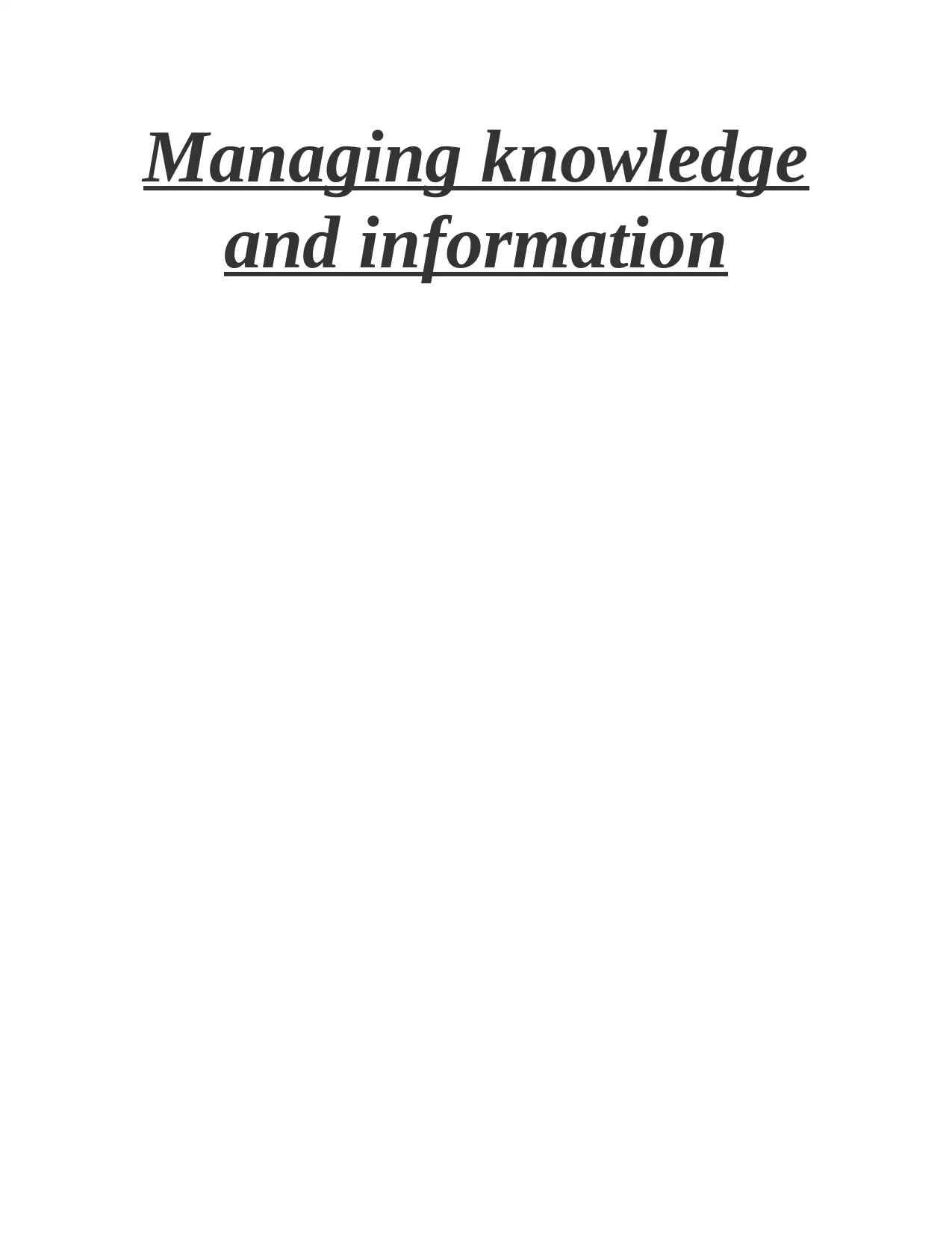
Managing knowledge
and information
and information
Secure Best Marks with AI Grader
Need help grading? Try our AI Grader for instant feedback on your assignments.
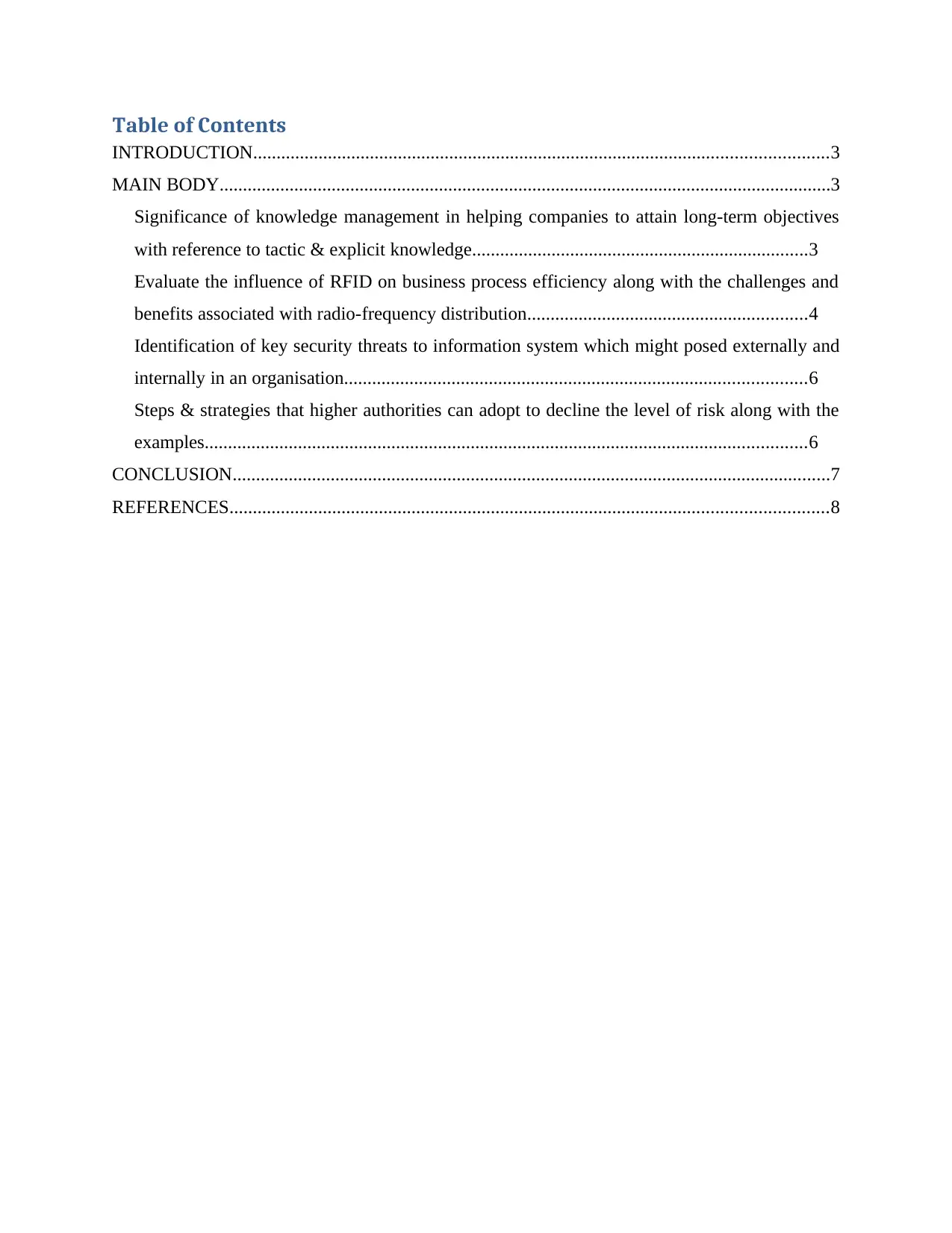
Table of Contents
INTRODUCTION...........................................................................................................................3
MAIN BODY...................................................................................................................................3
Significance of knowledge management in helping companies to attain long-term objectives
with reference to tactic & explicit knowledge........................................................................3
Evaluate the influence of RFID on business process efficiency along with the challenges and
benefits associated with radio-frequency distribution............................................................4
Identification of key security threats to information system which might posed externally and
internally in an organisation...................................................................................................6
Steps & strategies that higher authorities can adopt to decline the level of risk along with the
examples.................................................................................................................................6
CONCLUSION................................................................................................................................7
REFERENCES................................................................................................................................8
INTRODUCTION...........................................................................................................................3
MAIN BODY...................................................................................................................................3
Significance of knowledge management in helping companies to attain long-term objectives
with reference to tactic & explicit knowledge........................................................................3
Evaluate the influence of RFID on business process efficiency along with the challenges and
benefits associated with radio-frequency distribution............................................................4
Identification of key security threats to information system which might posed externally and
internally in an organisation...................................................................................................6
Steps & strategies that higher authorities can adopt to decline the level of risk along with the
examples.................................................................................................................................6
CONCLUSION................................................................................................................................7
REFERENCES................................................................................................................................8
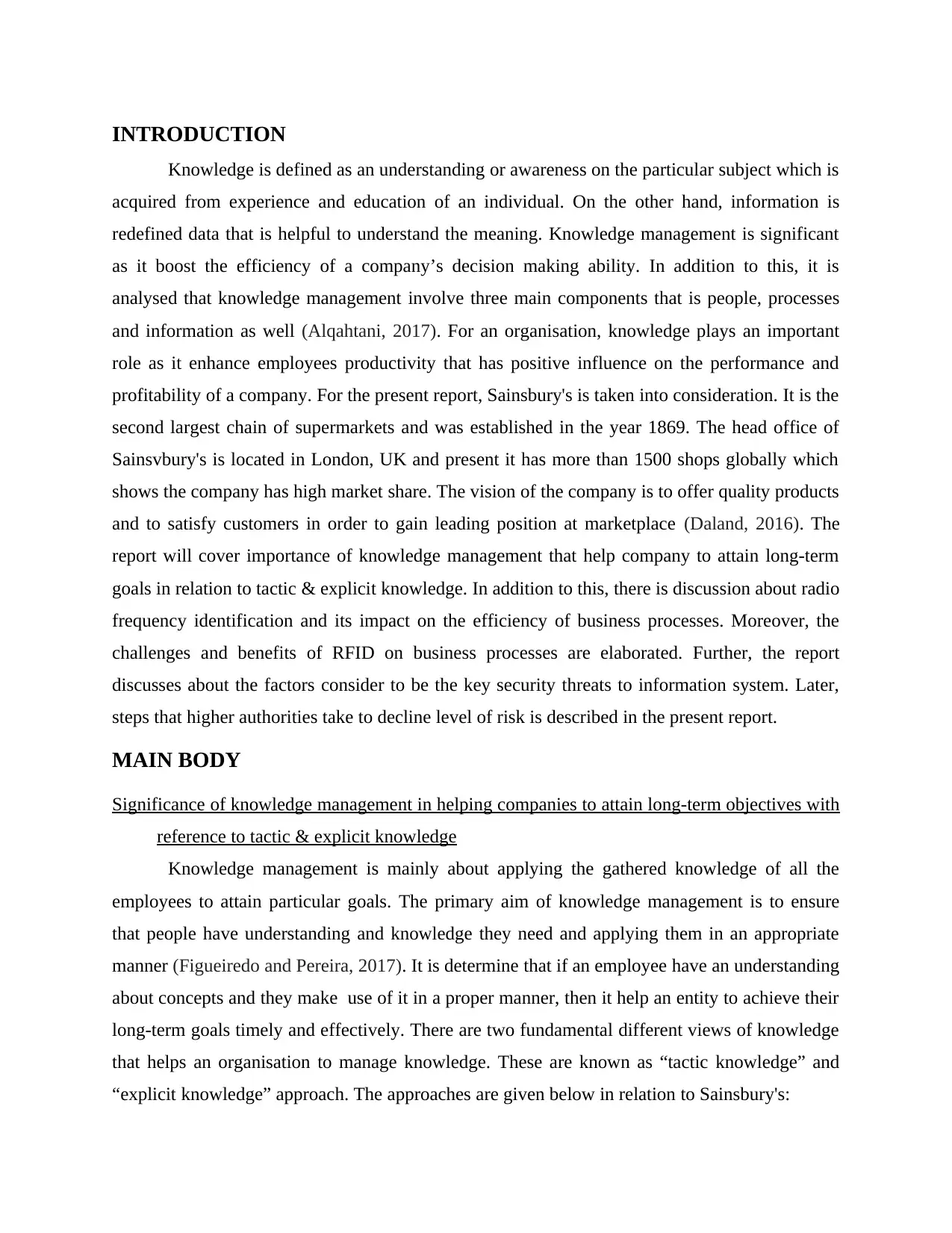
INTRODUCTION
Knowledge is defined as an understanding or awareness on the particular subject which is
acquired from experience and education of an individual. On the other hand, information is
redefined data that is helpful to understand the meaning. Knowledge management is significant
as it boost the efficiency of a company’s decision making ability. In addition to this, it is
analysed that knowledge management involve three main components that is people, processes
and information as well (Alqahtani, 2017). For an organisation, knowledge plays an important
role as it enhance employees productivity that has positive influence on the performance and
profitability of a company. For the present report, Sainsbury's is taken into consideration. It is the
second largest chain of supermarkets and was established in the year 1869. The head office of
Sainsvbury's is located in London, UK and present it has more than 1500 shops globally which
shows the company has high market share. The vision of the company is to offer quality products
and to satisfy customers in order to gain leading position at marketplace (Daland, 2016). The
report will cover importance of knowledge management that help company to attain long-term
goals in relation to tactic & explicit knowledge. In addition to this, there is discussion about radio
frequency identification and its impact on the efficiency of business processes. Moreover, the
challenges and benefits of RFID on business processes are elaborated. Further, the report
discusses about the factors consider to be the key security threats to information system. Later,
steps that higher authorities take to decline level of risk is described in the present report.
MAIN BODY
Significance of knowledge management in helping companies to attain long-term objectives with
reference to tactic & explicit knowledge
Knowledge management is mainly about applying the gathered knowledge of all the
employees to attain particular goals. The primary aim of knowledge management is to ensure
that people have understanding and knowledge they need and applying them in an appropriate
manner (Figueiredo and Pereira, 2017). It is determine that if an employee have an understanding
about concepts and they make use of it in a proper manner, then it help an entity to achieve their
long-term goals timely and effectively. There are two fundamental different views of knowledge
that helps an organisation to manage knowledge. These are known as “tactic knowledge” and
“explicit knowledge” approach. The approaches are given below in relation to Sainsbury's:
Knowledge is defined as an understanding or awareness on the particular subject which is
acquired from experience and education of an individual. On the other hand, information is
redefined data that is helpful to understand the meaning. Knowledge management is significant
as it boost the efficiency of a company’s decision making ability. In addition to this, it is
analysed that knowledge management involve three main components that is people, processes
and information as well (Alqahtani, 2017). For an organisation, knowledge plays an important
role as it enhance employees productivity that has positive influence on the performance and
profitability of a company. For the present report, Sainsbury's is taken into consideration. It is the
second largest chain of supermarkets and was established in the year 1869. The head office of
Sainsvbury's is located in London, UK and present it has more than 1500 shops globally which
shows the company has high market share. The vision of the company is to offer quality products
and to satisfy customers in order to gain leading position at marketplace (Daland, 2016). The
report will cover importance of knowledge management that help company to attain long-term
goals in relation to tactic & explicit knowledge. In addition to this, there is discussion about radio
frequency identification and its impact on the efficiency of business processes. Moreover, the
challenges and benefits of RFID on business processes are elaborated. Further, the report
discusses about the factors consider to be the key security threats to information system. Later,
steps that higher authorities take to decline level of risk is described in the present report.
MAIN BODY
Significance of knowledge management in helping companies to attain long-term objectives with
reference to tactic & explicit knowledge
Knowledge management is mainly about applying the gathered knowledge of all the
employees to attain particular goals. The primary aim of knowledge management is to ensure
that people have understanding and knowledge they need and applying them in an appropriate
manner (Figueiredo and Pereira, 2017). It is determine that if an employee have an understanding
about concepts and they make use of it in a proper manner, then it help an entity to achieve their
long-term goals timely and effectively. There are two fundamental different views of knowledge
that helps an organisation to manage knowledge. These are known as “tactic knowledge” and
“explicit knowledge” approach. The approaches are given below in relation to Sainsbury's:
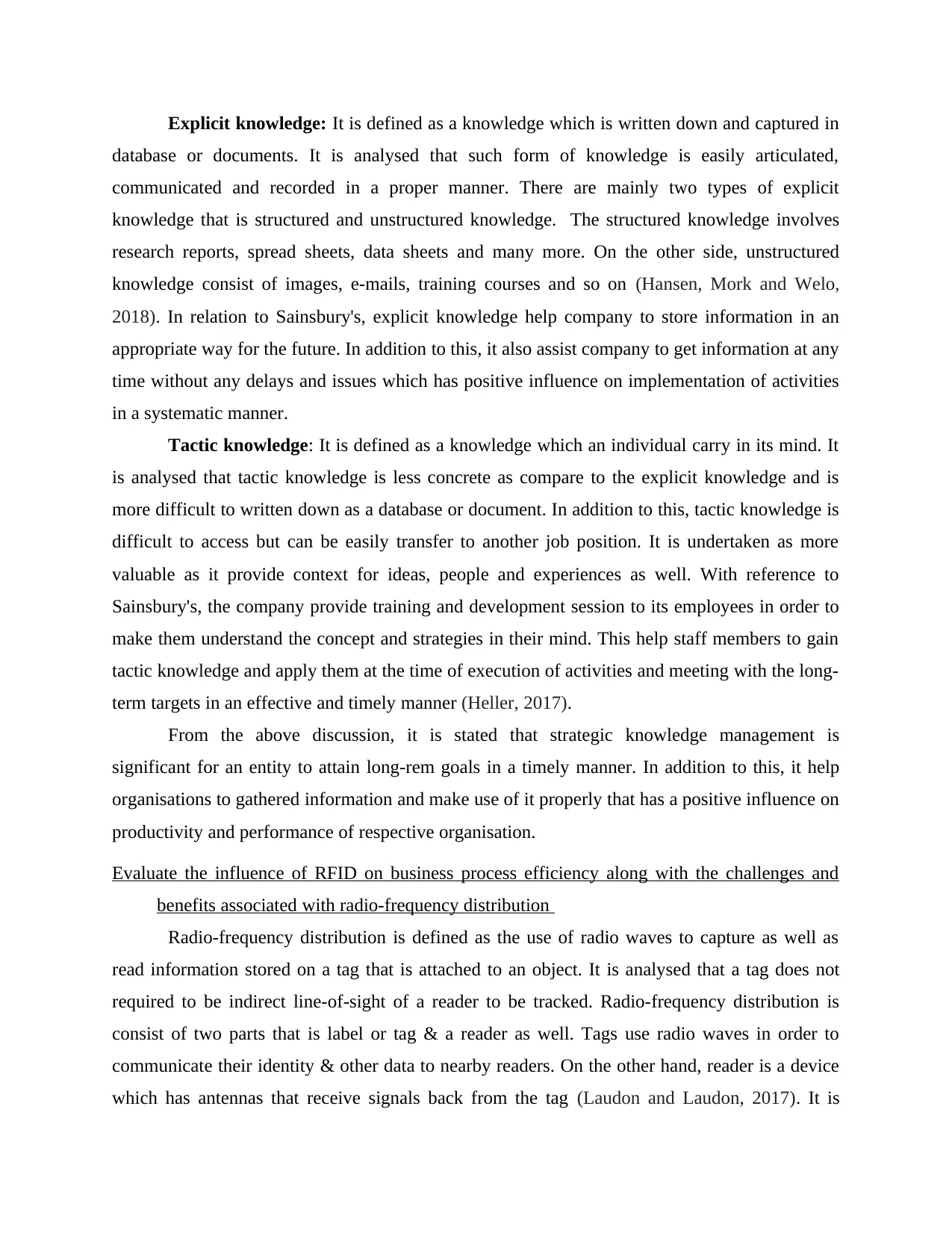
Explicit knowledge: It is defined as a knowledge which is written down and captured in
database or documents. It is analysed that such form of knowledge is easily articulated,
communicated and recorded in a proper manner. There are mainly two types of explicit
knowledge that is structured and unstructured knowledge. The structured knowledge involves
research reports, spread sheets, data sheets and many more. On the other side, unstructured
knowledge consist of images, e-mails, training courses and so on (Hansen, Mork and Welo,
2018). In relation to Sainsbury's, explicit knowledge help company to store information in an
appropriate way for the future. In addition to this, it also assist company to get information at any
time without any delays and issues which has positive influence on implementation of activities
in a systematic manner.
Tactic knowledge: It is defined as a knowledge which an individual carry in its mind. It
is analysed that tactic knowledge is less concrete as compare to the explicit knowledge and is
more difficult to written down as a database or document. In addition to this, tactic knowledge is
difficult to access but can be easily transfer to another job position. It is undertaken as more
valuable as it provide context for ideas, people and experiences as well. With reference to
Sainsbury's, the company provide training and development session to its employees in order to
make them understand the concept and strategies in their mind. This help staff members to gain
tactic knowledge and apply them at the time of execution of activities and meeting with the long-
term targets in an effective and timely manner (Heller, 2017).
From the above discussion, it is stated that strategic knowledge management is
significant for an entity to attain long-rem goals in a timely manner. In addition to this, it help
organisations to gathered information and make use of it properly that has a positive influence on
productivity and performance of respective organisation.
Evaluate the influence of RFID on business process efficiency along with the challenges and
benefits associated with radio-frequency distribution
Radio-frequency distribution is defined as the use of radio waves to capture as well as
read information stored on a tag that is attached to an object. It is analysed that a tag does not
required to be indirect line-of-sight of a reader to be tracked. Radio-frequency distribution is
consist of two parts that is label or tag & a reader as well. Tags use radio waves in order to
communicate their identity & other data to nearby readers. On the other hand, reader is a device
which has antennas that receive signals back from the tag (Laudon and Laudon, 2017). It is
database or documents. It is analysed that such form of knowledge is easily articulated,
communicated and recorded in a proper manner. There are mainly two types of explicit
knowledge that is structured and unstructured knowledge. The structured knowledge involves
research reports, spread sheets, data sheets and many more. On the other side, unstructured
knowledge consist of images, e-mails, training courses and so on (Hansen, Mork and Welo,
2018). In relation to Sainsbury's, explicit knowledge help company to store information in an
appropriate way for the future. In addition to this, it also assist company to get information at any
time without any delays and issues which has positive influence on implementation of activities
in a systematic manner.
Tactic knowledge: It is defined as a knowledge which an individual carry in its mind. It
is analysed that tactic knowledge is less concrete as compare to the explicit knowledge and is
more difficult to written down as a database or document. In addition to this, tactic knowledge is
difficult to access but can be easily transfer to another job position. It is undertaken as more
valuable as it provide context for ideas, people and experiences as well. With reference to
Sainsbury's, the company provide training and development session to its employees in order to
make them understand the concept and strategies in their mind. This help staff members to gain
tactic knowledge and apply them at the time of execution of activities and meeting with the long-
term targets in an effective and timely manner (Heller, 2017).
From the above discussion, it is stated that strategic knowledge management is
significant for an entity to attain long-rem goals in a timely manner. In addition to this, it help
organisations to gathered information and make use of it properly that has a positive influence on
productivity and performance of respective organisation.
Evaluate the influence of RFID on business process efficiency along with the challenges and
benefits associated with radio-frequency distribution
Radio-frequency distribution is defined as the use of radio waves to capture as well as
read information stored on a tag that is attached to an object. It is analysed that a tag does not
required to be indirect line-of-sight of a reader to be tracked. Radio-frequency distribution is
consist of two parts that is label or tag & a reader as well. Tags use radio waves in order to
communicate their identity & other data to nearby readers. On the other hand, reader is a device
which has antennas that receive signals back from the tag (Laudon and Laudon, 2017). It is
Paraphrase This Document
Need a fresh take? Get an instant paraphrase of this document with our AI Paraphraser
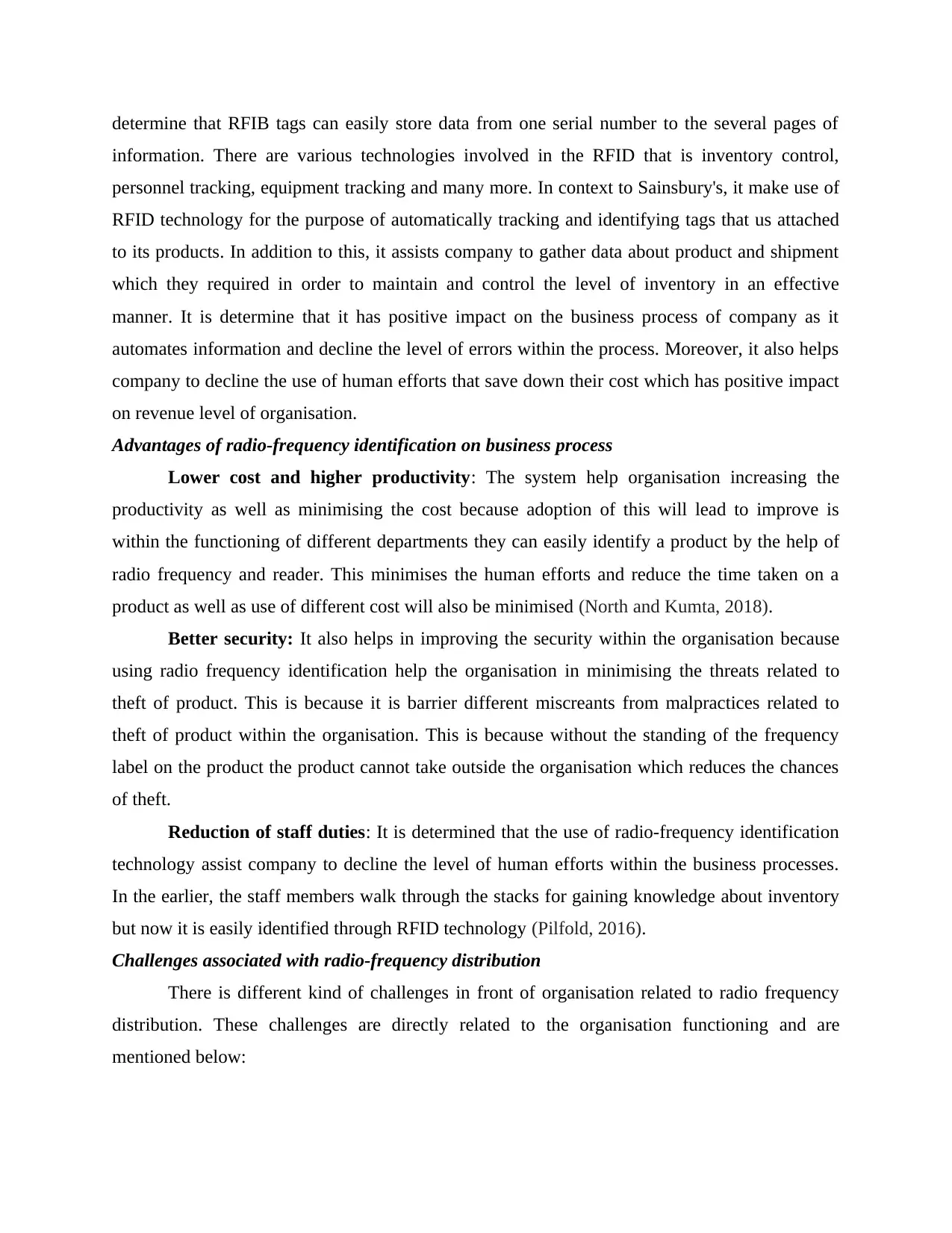
determine that RFIB tags can easily store data from one serial number to the several pages of
information. There are various technologies involved in the RFID that is inventory control,
personnel tracking, equipment tracking and many more. In context to Sainsbury's, it make use of
RFID technology for the purpose of automatically tracking and identifying tags that us attached
to its products. In addition to this, it assists company to gather data about product and shipment
which they required in order to maintain and control the level of inventory in an effective
manner. It is determine that it has positive impact on the business process of company as it
automates information and decline the level of errors within the process. Moreover, it also helps
company to decline the use of human efforts that save down their cost which has positive impact
on revenue level of organisation.
Advantages of radio-frequency identification on business process
Lower cost and higher productivity: The system help organisation increasing the
productivity as well as minimising the cost because adoption of this will lead to improve is
within the functioning of different departments they can easily identify a product by the help of
radio frequency and reader. This minimises the human efforts and reduce the time taken on a
product as well as use of different cost will also be minimised (North and Kumta, 2018).
Better security: It also helps in improving the security within the organisation because
using radio frequency identification help the organisation in minimising the threats related to
theft of product. This is because it is barrier different miscreants from malpractices related to
theft of product within the organisation. This is because without the standing of the frequency
label on the product the product cannot take outside the organisation which reduces the chances
of theft.
Reduction of staff duties: It is determined that the use of radio-frequency identification
technology assist company to decline the level of human efforts within the business processes.
In the earlier, the staff members walk through the stacks for gaining knowledge about inventory
but now it is easily identified through RFID technology (Pilfold, 2016).
Challenges associated with radio-frequency distribution
There is different kind of challenges in front of organisation related to radio frequency
distribution. These challenges are directly related to the organisation functioning and are
mentioned below:
information. There are various technologies involved in the RFID that is inventory control,
personnel tracking, equipment tracking and many more. In context to Sainsbury's, it make use of
RFID technology for the purpose of automatically tracking and identifying tags that us attached
to its products. In addition to this, it assists company to gather data about product and shipment
which they required in order to maintain and control the level of inventory in an effective
manner. It is determine that it has positive impact on the business process of company as it
automates information and decline the level of errors within the process. Moreover, it also helps
company to decline the use of human efforts that save down their cost which has positive impact
on revenue level of organisation.
Advantages of radio-frequency identification on business process
Lower cost and higher productivity: The system help organisation increasing the
productivity as well as minimising the cost because adoption of this will lead to improve is
within the functioning of different departments they can easily identify a product by the help of
radio frequency and reader. This minimises the human efforts and reduce the time taken on a
product as well as use of different cost will also be minimised (North and Kumta, 2018).
Better security: It also helps in improving the security within the organisation because
using radio frequency identification help the organisation in minimising the threats related to
theft of product. This is because it is barrier different miscreants from malpractices related to
theft of product within the organisation. This is because without the standing of the frequency
label on the product the product cannot take outside the organisation which reduces the chances
of theft.
Reduction of staff duties: It is determined that the use of radio-frequency identification
technology assist company to decline the level of human efforts within the business processes.
In the earlier, the staff members walk through the stacks for gaining knowledge about inventory
but now it is easily identified through RFID technology (Pilfold, 2016).
Challenges associated with radio-frequency distribution
There is different kind of challenges in front of organisation related to radio frequency
distribution. These challenges are directly related to the organisation functioning and are
mentioned below:
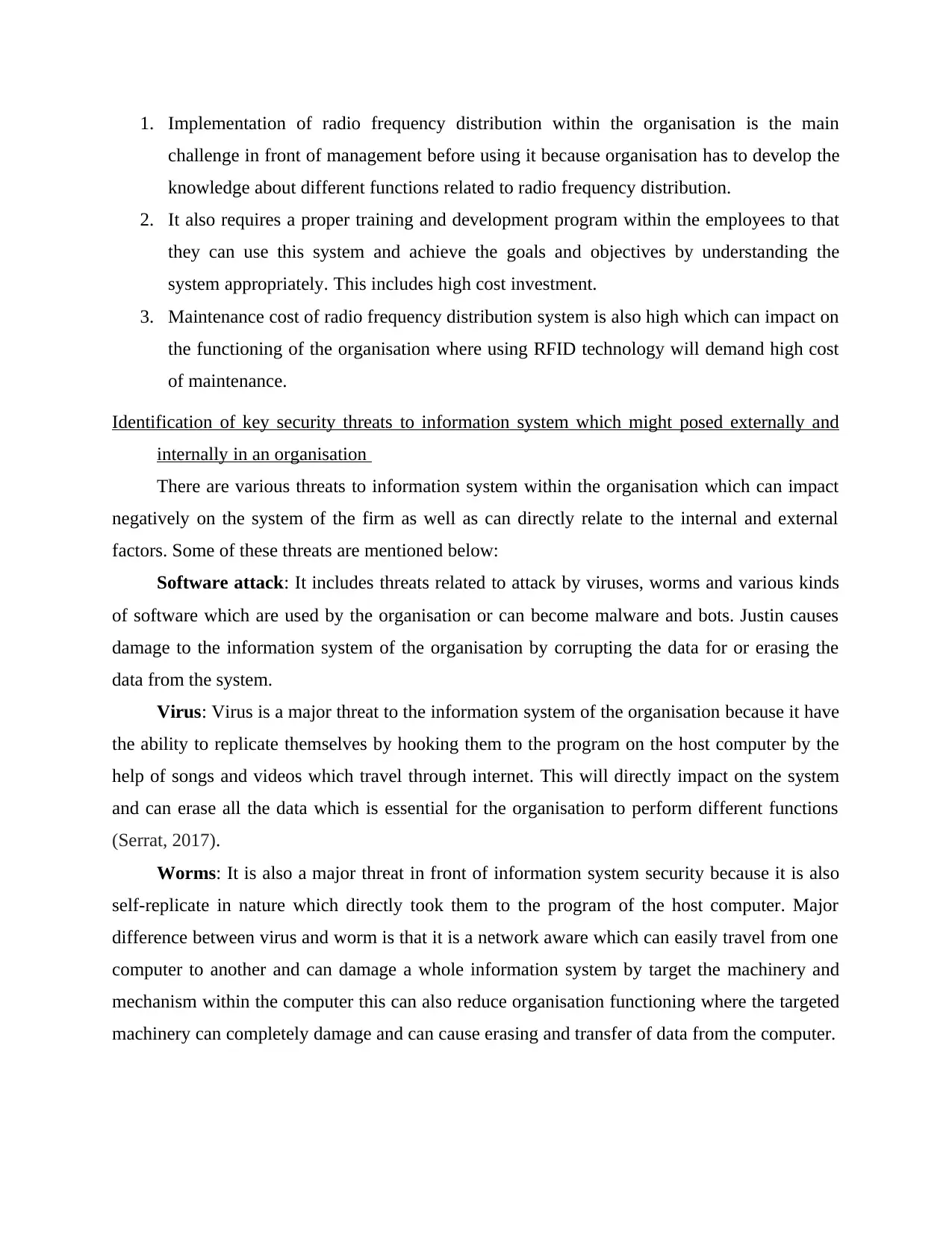
1. Implementation of radio frequency distribution within the organisation is the main
challenge in front of management before using it because organisation has to develop the
knowledge about different functions related to radio frequency distribution.
2. It also requires a proper training and development program within the employees to that
they can use this system and achieve the goals and objectives by understanding the
system appropriately. This includes high cost investment.
3. Maintenance cost of radio frequency distribution system is also high which can impact on
the functioning of the organisation where using RFID technology will demand high cost
of maintenance.
Identification of key security threats to information system which might posed externally and
internally in an organisation
There are various threats to information system within the organisation which can impact
negatively on the system of the firm as well as can directly relate to the internal and external
factors. Some of these threats are mentioned below:
Software attack: It includes threats related to attack by viruses, worms and various kinds
of software which are used by the organisation or can become malware and bots. Justin causes
damage to the information system of the organisation by corrupting the data for or erasing the
data from the system.
Virus: Virus is a major threat to the information system of the organisation because it have
the ability to replicate themselves by hooking them to the program on the host computer by the
help of songs and videos which travel through internet. This will directly impact on the system
and can erase all the data which is essential for the organisation to perform different functions
(Serrat, 2017).
Worms: It is also a major threat in front of information system security because it is also
self-replicate in nature which directly took them to the program of the host computer. Major
difference between virus and worm is that it is a network aware which can easily travel from one
computer to another and can damage a whole information system by target the machinery and
mechanism within the computer this can also reduce organisation functioning where the targeted
machinery can completely damage and can cause erasing and transfer of data from the computer.
challenge in front of management before using it because organisation has to develop the
knowledge about different functions related to radio frequency distribution.
2. It also requires a proper training and development program within the employees to that
they can use this system and achieve the goals and objectives by understanding the
system appropriately. This includes high cost investment.
3. Maintenance cost of radio frequency distribution system is also high which can impact on
the functioning of the organisation where using RFID technology will demand high cost
of maintenance.
Identification of key security threats to information system which might posed externally and
internally in an organisation
There are various threats to information system within the organisation which can impact
negatively on the system of the firm as well as can directly relate to the internal and external
factors. Some of these threats are mentioned below:
Software attack: It includes threats related to attack by viruses, worms and various kinds
of software which are used by the organisation or can become malware and bots. Justin causes
damage to the information system of the organisation by corrupting the data for or erasing the
data from the system.
Virus: Virus is a major threat to the information system of the organisation because it have
the ability to replicate themselves by hooking them to the program on the host computer by the
help of songs and videos which travel through internet. This will directly impact on the system
and can erase all the data which is essential for the organisation to perform different functions
(Serrat, 2017).
Worms: It is also a major threat in front of information system security because it is also
self-replicate in nature which directly took them to the program of the host computer. Major
difference between virus and worm is that it is a network aware which can easily travel from one
computer to another and can damage a whole information system by target the machinery and
mechanism within the computer this can also reduce organisation functioning where the targeted
machinery can completely damage and can cause erasing and transfer of data from the computer.
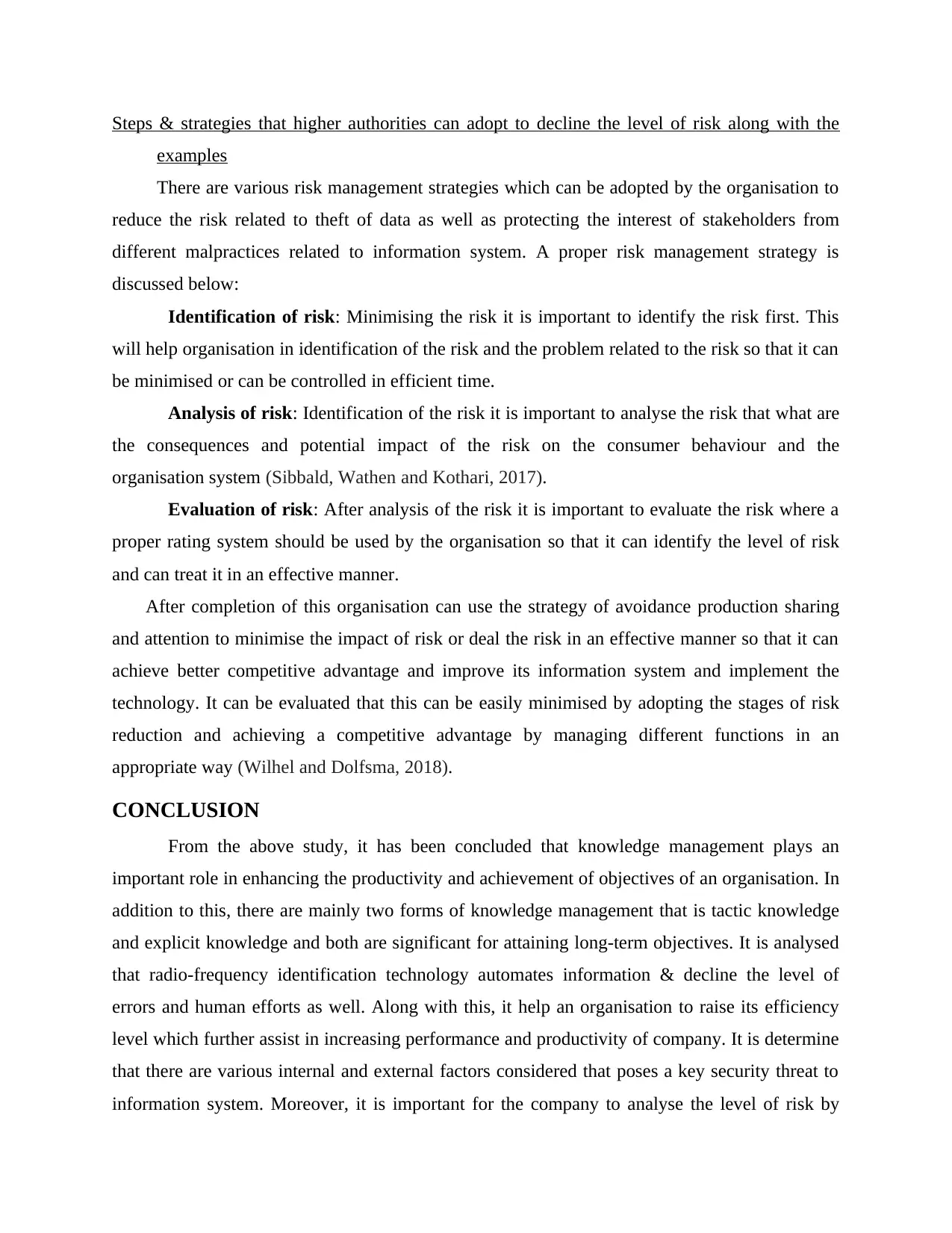
Steps & strategies that higher authorities can adopt to decline the level of risk along with the
examples
There are various risk management strategies which can be adopted by the organisation to
reduce the risk related to theft of data as well as protecting the interest of stakeholders from
different malpractices related to information system. A proper risk management strategy is
discussed below:
Identification of risk: Minimising the risk it is important to identify the risk first. This
will help organisation in identification of the risk and the problem related to the risk so that it can
be minimised or can be controlled in efficient time.
Analysis of risk: Identification of the risk it is important to analyse the risk that what are
the consequences and potential impact of the risk on the consumer behaviour and the
organisation system (Sibbald, Wathen and Kothari, 2017).
Evaluation of risk: After analysis of the risk it is important to evaluate the risk where a
proper rating system should be used by the organisation so that it can identify the level of risk
and can treat it in an effective manner.
After completion of this organisation can use the strategy of avoidance production sharing
and attention to minimise the impact of risk or deal the risk in an effective manner so that it can
achieve better competitive advantage and improve its information system and implement the
technology. It can be evaluated that this can be easily minimised by adopting the stages of risk
reduction and achieving a competitive advantage by managing different functions in an
appropriate way (Wilhel and Dolfsma, 2018).
CONCLUSION
From the above study, it has been concluded that knowledge management plays an
important role in enhancing the productivity and achievement of objectives of an organisation. In
addition to this, there are mainly two forms of knowledge management that is tactic knowledge
and explicit knowledge and both are significant for attaining long-term objectives. It is analysed
that radio-frequency identification technology automates information & decline the level of
errors and human efforts as well. Along with this, it help an organisation to raise its efficiency
level which further assist in increasing performance and productivity of company. It is determine
that there are various internal and external factors considered that poses a key security threat to
information system. Moreover, it is important for the company to analyse the level of risk by
examples
There are various risk management strategies which can be adopted by the organisation to
reduce the risk related to theft of data as well as protecting the interest of stakeholders from
different malpractices related to information system. A proper risk management strategy is
discussed below:
Identification of risk: Minimising the risk it is important to identify the risk first. This
will help organisation in identification of the risk and the problem related to the risk so that it can
be minimised or can be controlled in efficient time.
Analysis of risk: Identification of the risk it is important to analyse the risk that what are
the consequences and potential impact of the risk on the consumer behaviour and the
organisation system (Sibbald, Wathen and Kothari, 2017).
Evaluation of risk: After analysis of the risk it is important to evaluate the risk where a
proper rating system should be used by the organisation so that it can identify the level of risk
and can treat it in an effective manner.
After completion of this organisation can use the strategy of avoidance production sharing
and attention to minimise the impact of risk or deal the risk in an effective manner so that it can
achieve better competitive advantage and improve its information system and implement the
technology. It can be evaluated that this can be easily minimised by adopting the stages of risk
reduction and achieving a competitive advantage by managing different functions in an
appropriate way (Wilhel and Dolfsma, 2018).
CONCLUSION
From the above study, it has been concluded that knowledge management plays an
important role in enhancing the productivity and achievement of objectives of an organisation. In
addition to this, there are mainly two forms of knowledge management that is tactic knowledge
and explicit knowledge and both are significant for attaining long-term objectives. It is analysed
that radio-frequency identification technology automates information & decline the level of
errors and human efforts as well. Along with this, it help an organisation to raise its efficiency
level which further assist in increasing performance and productivity of company. It is determine
that there are various internal and external factors considered that poses a key security threat to
information system. Moreover, it is important for the company to analyse the level of risk by
Secure Best Marks with AI Grader
Need help grading? Try our AI Grader for instant feedback on your assignments.

using risk mitigation techniques as it help reducing risk and maintain the level of performance in
an appropriate manner.
an appropriate manner.
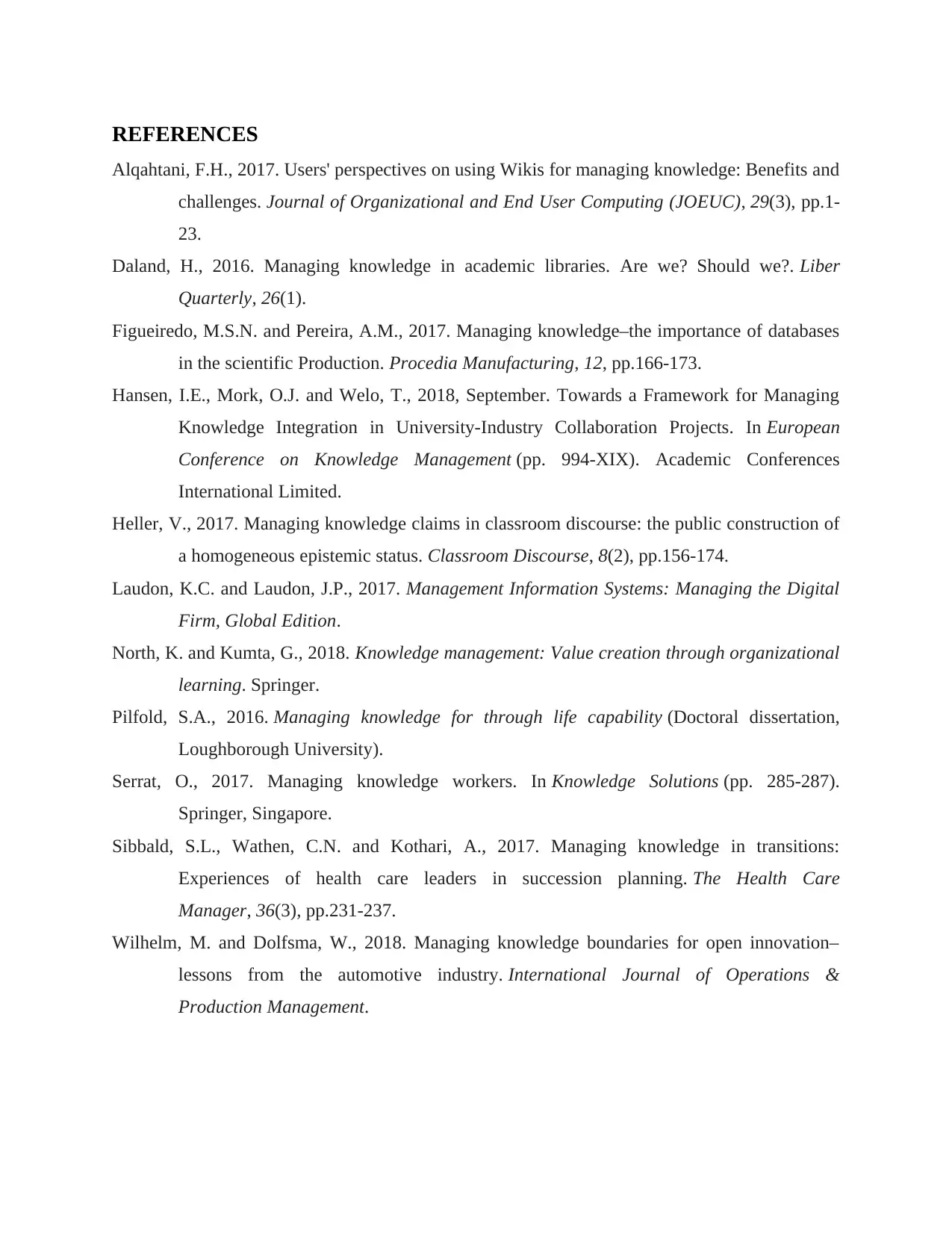
REFERENCES
Alqahtani, F.H., 2017. Users' perspectives on using Wikis for managing knowledge: Benefits and
challenges. Journal of Organizational and End User Computing (JOEUC), 29(3), pp.1-
23.
Daland, H., 2016. Managing knowledge in academic libraries. Are we? Should we?. Liber
Quarterly, 26(1).
Figueiredo, M.S.N. and Pereira, A.M., 2017. Managing knowledge–the importance of databases
in the scientific Production. Procedia Manufacturing, 12, pp.166-173.
Hansen, I.E., Mork, O.J. and Welo, T., 2018, September. Towards a Framework for Managing
Knowledge Integration in University-Industry Collaboration Projects. In European
Conference on Knowledge Management (pp. 994-XIX). Academic Conferences
International Limited.
Heller, V., 2017. Managing knowledge claims in classroom discourse: the public construction of
a homogeneous epistemic status. Classroom Discourse, 8(2), pp.156-174.
Laudon, K.C. and Laudon, J.P., 2017. Management Information Systems: Managing the Digital
Firm, Global Edition.
North, K. and Kumta, G., 2018. Knowledge management: Value creation through organizational
learning. Springer.
Pilfold, S.A., 2016. Managing knowledge for through life capability (Doctoral dissertation,
Loughborough University).
Serrat, O., 2017. Managing knowledge workers. In Knowledge Solutions (pp. 285-287).
Springer, Singapore.
Sibbald, S.L., Wathen, C.N. and Kothari, A., 2017. Managing knowledge in transitions:
Experiences of health care leaders in succession planning. The Health Care
Manager, 36(3), pp.231-237.
Wilhelm, M. and Dolfsma, W., 2018. Managing knowledge boundaries for open innovation–
lessons from the automotive industry. International Journal of Operations &
Production Management.
Alqahtani, F.H., 2017. Users' perspectives on using Wikis for managing knowledge: Benefits and
challenges. Journal of Organizational and End User Computing (JOEUC), 29(3), pp.1-
23.
Daland, H., 2016. Managing knowledge in academic libraries. Are we? Should we?. Liber
Quarterly, 26(1).
Figueiredo, M.S.N. and Pereira, A.M., 2017. Managing knowledge–the importance of databases
in the scientific Production. Procedia Manufacturing, 12, pp.166-173.
Hansen, I.E., Mork, O.J. and Welo, T., 2018, September. Towards a Framework for Managing
Knowledge Integration in University-Industry Collaboration Projects. In European
Conference on Knowledge Management (pp. 994-XIX). Academic Conferences
International Limited.
Heller, V., 2017. Managing knowledge claims in classroom discourse: the public construction of
a homogeneous epistemic status. Classroom Discourse, 8(2), pp.156-174.
Laudon, K.C. and Laudon, J.P., 2017. Management Information Systems: Managing the Digital
Firm, Global Edition.
North, K. and Kumta, G., 2018. Knowledge management: Value creation through organizational
learning. Springer.
Pilfold, S.A., 2016. Managing knowledge for through life capability (Doctoral dissertation,
Loughborough University).
Serrat, O., 2017. Managing knowledge workers. In Knowledge Solutions (pp. 285-287).
Springer, Singapore.
Sibbald, S.L., Wathen, C.N. and Kothari, A., 2017. Managing knowledge in transitions:
Experiences of health care leaders in succession planning. The Health Care
Manager, 36(3), pp.231-237.
Wilhelm, M. and Dolfsma, W., 2018. Managing knowledge boundaries for open innovation–
lessons from the automotive industry. International Journal of Operations &
Production Management.
1 out of 9
![[object Object]](/_next/static/media/star-bottom.7253800d.svg)





